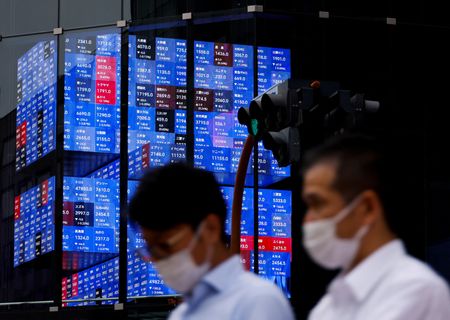
By Stella Qiu
SYDNEY (Reuters) – Asian shares were flat and Treasuries held onto gains on Friday ahead of the U.S. non-farm payrolls data, the next big test for investors looking for more signs of a shift from the Federal Reserve, while the dollar nursed heavy losses.
MSCI’s broadest index of Asia-Pacific shares outside Japan lost 0.2% in early trade. Nonetheless, the index is set to rise 4.2% for the week, hovering around the highest level since September.
Japan’s Nikkei fell 1.5%.
S&P 500 futures eased 0.3%, while Nasdaq futures fell 0.4%%. U.S. shares ended mixed on Thursday after a big rally the day before, buoyed by comments from Fed Chair Jerome Powell that did not sound as hawkish as some had feared.
U.S. data overnight including falling U.S. job openings and contracting U.S. manufacturing activity pointing to signs of easing cost pressure added to evidence that the Fed’s rate hikes have cooled the economy.
Investors are also watching for more signs that China is easing its zero-COVID policy, and whether China would contribute more to global growth next year amid a looming global recession.
Chinese bluechips opened 0.2% lower while Hong Kong’s Hang Seng index edged 0.3% higher.
Sources told Reuters that China is set to announce an easing of its COVID-19 quarantine protocols in the coming days and a reduction in mass testing, a marked shift in policy after anger over the world’s toughest curbs fuelled widespread protests.
Shane Oliver, chief economist at AMP Capital, said markets, after the strong recent rally, in some cases are up to around technical resistance levels, and it may take a while to get through those points.
“But I suspect given the increasing signs that inflation is peaking globally and China is easing its COVID restrictions moving away from zero COVID – they haven’t said as much but certainly it is moving away from zero COVID – that those things are probably positive,” he said.
“I think the rally can probably continue but in the short-term the payrolls are the one to watch closely.”
Alan Ruskin, macro strategist at Deutsche Bank, said if the nonfarm payrolls increased by from 50,000 to 150,000 in November, that would be favourable for bonds and equities and keep the U.S. dollar trading on the backfoot.
Economists polled by Reuters expect payrolls likely rose 200,000 in November.
Futures have priced in a 78% chance of a rise of 50 basis points at the December’s policy meeting, while rates are now expected to peak around 4.75% to 5% by mid next year, compared with 5% to 5.25% previously.
In the bond markets, Treasuries held onto their gains after two straight days of rally. The yields on benchmark 10-year Treasury notes were largely steady at 3.5303%, compared with its U.S. close of 3.527%.
The two-year yield, which rises with traders’ expectations of higher Fed fund rates, was little changed at 4.2584%, compared with a U.S. close of 4.254%.
The U.S dollar on Friday hovered around its three-month low against a basket of major currencies and was set for a 1.2% weekly drop.
The Euro hit a fresh five-month high at $1.0539 while the Japanese yen also scaled a new three-month high against the U.S. dollar.
The Aussie dollar dipped slightly to $0.6796, after blowing past major resistance at 68 cents in the previous session, on Fed pivot hopes and China easing its zero-COVID policy.
In the oil market, prices eased ahead of the OPEC’s meeting over the weekend.
U.S. crude oil futures fell 0.33% to around $81.02 per barrel, after surging to a two-week high of $83.34 in the previous session on a softer dollar.
Brent crude futures eased 0.26% to $86.61 per barrel.
Gold was slightly lower. Spot gold was traded at $1799.44 per ounce.
(Editing by Stephen Coates)

